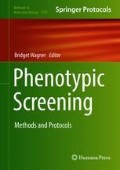Abstract
A riboflavin biosynthesis pathway-specific phenotypic screen using a library of compounds, all with unspecified antibiotic activity, identified one small molecule later named ribocil, for which intrinsic antibacterial activity against Escherichia coli was completely suppressed by addition of exogenous riboflavin to the bacterial growth medium. The ability of riboflavin to suppress the activity of ribocil, and further demonstration that ribocil inhibited riboflavin synthesis (IC50 = 0.3 μM), supported that a component of the riboflavin synthesis pathway was the molecular target. Remarkably, resistance mutation selection and whole-genome sequencing showed that the target of ribocil was not an enzyme in the riboflavin biosynthesis pathway, but instead the flavin mononucleotide riboswitch, a noncoding structural RNA element in the ribB gene that encodes a key riboflavin synthesis enzyme. Although ribocil is structurally distinct from the natural riboswitch regulatory ligand flavin mononucleotide, ribocil binding to the riboswitch results in efficient repression of ribB expression and inhibition of riboflavin biosynthesis and bacterial growth. A cell-based riboswitch regulated gene reporter assay as well as an in vitro riboswitch RNA aptamer-binding assay, both of which are described in detail here along with the riboflavin pathway-specific screen, were developed to further validate the mechanism of action of ribocil and to facilitate the discovery of more potent analogues.
Access this chapter
Tax calculation will be finalised at checkout
Purchases are for personal use only
References
Howe JA, Wang H, Fischmann TO, Balibar CJ, Xiao L, Galgocci A et al (2015) Selective small-molecule inhibition of an RNA structural element. Nature 526:672–677
Bacher A (1991) Riboflavin kinase and FAD synthetase. In: Müller F (ed) Chemistry and biochemistry of flavoenzymes. CRC Press, Boca Raton, FL, pp 349–370
Fischer M, Bacher A (2005) Biosynthesis of flavocoenzymes. Nat Prod Rep 22:324–350
Gelfand MS, Mironov AA, Jomantas J, Kozlov YI, Perumov DAA (1999) Conserved RNA structure element involved in the regulation of bacterial RF synthesis genes. Trends Genet 15:439–442
Vitreschak AG, Rodionov DA, Mironov AA, Gelfand MS (2002) Regulation of RF biosynthesis and transport genes in bacteria by transcriptional and translational attenuation. Nucleic Acids Res 30:3141–3151
Winkler WC, Cohen-Chalamish S, Breaker RR (2002) An mRNA structure that controls gene expression by binding FMN. Proc Natl Acad Sci USA 99:15908–15913
Lee ER, Blount KF, Breaker RR (2009) Roseoflavin is a natural antibacterial compound that binds to FMN riboswitches and regulates gene expression. RNA Biol 6:187–194
Serganov A, Nudler A (2013) A decade of riboswitches. Cell 152:17–24
Lünse CE, Schüller A, Mayer G (2014) The promise of riboswitches as potential antibacterial drug targets. Int J Med Microbiol 304:79–92
Mandal M, Breaker RR (2004) Gene regulation by riboswitches. Nat Rev Mol Cell Biol 5:451–463
Zerbino DR, Birney E (2008) Velvet: algorithms for de novo short read assembly using de Bruijn graphs. Genome Res 18:821–829
Li H, Durbin R (2009) Fast and accurate short read alignment with Burrows–Wheeler transform. Bioinformatics 25:1754–1760
McKenna A, Hanna M, Banks E, Sivachenko A, Cibulskis K, Kernytsky A et al (2010) The Genome Analysis Toolkit: a MapReduce framework for analyzing next-generation DNA sequencing data. Genome Res 20:1297–1303
Nusbaum C, Ohsumi TK, Gomez J, Aquadro J, Victor TC, Warren RM et al (2009) Sensitive, specific polymorphism discovery in bacteria using massively parallel sequencing. Nat Methods 6:67–69
Author information
Authors and Affiliations
Corresponding author
Editor information
Editors and Affiliations
Rights and permissions
Copyright information
© 2018 Springer Science+Business Media, LLC, part of Springer Nature
About this protocol
Cite this protocol
Balibar, C.J. et al. (2018). Validation and Development of an Escherichia coli Riboflavin Pathway Phenotypic Screen Hit as a Small-Molecule Ligand of the Flavin Mononucleotide Riboswitch. In: Wagner, B. (eds) Phenotypic Screening. Methods in Molecular Biology, vol 1787. Humana Press, New York, NY. https://doi.org/10.1007/978-1-4939-7847-2_2
Download citation
DOI: https://doi.org/10.1007/978-1-4939-7847-2_2
Published:
Publisher Name: Humana Press, New York, NY
Print ISBN: 978-1-4939-7846-5
Online ISBN: 978-1-4939-7847-2
eBook Packages: Springer Protocols

